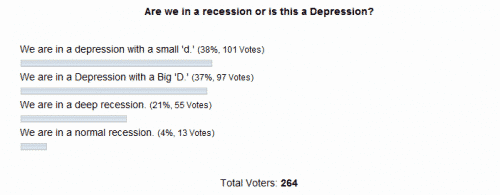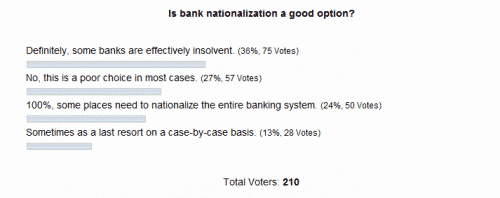We are in depression
The results of my poll are back and according to readers we are clearly in Depression. A plurality of you voted for depression with a small ‘d,’ edging out those who see Depression with a Big ‘D.’
I agree with this assessment as I also voted for a depression with a small ‘d.’ Let me tell you why.
In my view, this downturn is clearly not a recession, but something more significant. What we are experiencing is different from garden variety recessions because of the ‘D-process’ as explained by Ray Dalio in a recent post.
In a recession, companies figure out that they have over-produced i.e. overestimated demand as the economy begins to slow. They cut back production, lay off workers and de-stock inventories to readjust. As a result, recession takes hold. Eventually though, everything falls back into balance and you are off to the races again.
Depression is a whole different ball of wax. Here, Ray Dalio’s D-process is a self-reinforcing dowward cycle that takes place as a result of the confluence of deleveraging and debt deflation, leading to depression. I euphemistically call this the Three D’s. And it is the self-reinforcing nature of the Three D’s that makes these down cycles especially problematic. You can view this from the lens of the creditor or the debtor and the self-reinforcement is identical.
Creditor’s view
In a deflationary downturn, lenders find themselves over-leveraged with too little capital to support their asset base. This can occur even in the absence of increased leverage during the up-cycle because, after an unsustainable rise in asset prices, creditors are fooled into holding too little capital in reserve. Say you have assets on your books that you thought were worth $100, but are now worth $70, even if you were over-capitalized by 20%, you suddenly have a shortfall of 10% (see my posts De-leveraging and De-leveraging redux for more on this de-leveraging process).
There are three ways to deal with your shortfall. You can issue more shares or you can earn more money, thereby increasing your capital. Or you can shed assets – otherwise known as de-leveraging, thereby reducing the capital needed. Remember, financial institutions without enough capital get seized by the government or fail spectactularly — two fates you want to avoid.
Now, if this were a recession, all of this would be easy to deal with. You just issue shares (a la Citibank after early 1990s recession) or you grow your way out of capital inadequacy (which is what the Japanese tried to do). But in a depression, banks don’t make money and no one is willing to buy more shares. So, you are out of luck on the capital raising front. That means you need to shed assets. The problem with all of that is that, in a depression, everyone is shedding assets simultaneously. In a recession, only some weaker hands are shedding assets. But, in depression, everyone is. And when everyone is a seller and no one is a buyer, prices fall (this is asset deflation). When the prices of your assets fall, you need to sell even more assets to make up for a greater capital shortfall and on it goes.
The spiral is broken by either a weeding out of weak hands, which returns asset supply and demand back to relative balance or government recapitalizing firms. If all of this sounds familiar to you, it should because this is exactly what is happening in the U.S., in the U.K., in Ireland and even in the Eurozone right now.
Debtors’ view
The view from the debtor’s standpoint is much the same. Before the depression, debtors bought assets with leverage or at low interest rates. The asset price increases and the low interest rates masked how unaffordable these purchases were. When interest rates rise and/or asset prices (and income from those assets) fall, it becomes apparent that the debt servicing burden is crushing. Then debtors must sell. But, since everyone is selling at the same time, asset prices and income fall further, interest rates rise for distressed debtors and on it goes. Again, the process is arrested only when weak hands are weeded out or the government gives the debtors some measure of relief.
This downward spiral is applicable to over-leveraged companies as much as it is for individuals and describes what is now taking place.
Conclusion
The upshot of this analysis is that arresting the downward spiral is the key to ending the depression. The reason I see the present cycle as a depression with a small ‘d’ is that policy makers across the globe are throwing everything at the problem they can think of. To my mind, this will likely but not necessarily eliminate worst-case outcomes. If policy makers sat back and did nothing, I am fairly confident that the weeding out of so-called weak hands on both the creditor and the debtor’s sides would lead to collapse and a major Depression.
The real question now is this: are policy makers doing enough and are they focused on the right variables likely to arrest the depressionary cycle? I am not convinced they are and this is why I still see major downside risk.
In that vein, I am introducing a new poll. The question:
I am sure I have tipped my hand as to where I stand on this issue, but don’t let that influence you. I would still love to hear your opinions as well.


What’s the difference between a deep recession and a depression? Click my name to find out!
Mark,
that’s good!
“The reason I see the present cycle as a depression with a small ‘d’ is that policy makers across the globe are throwing everything at the problem they can think of. To my mind, this will likely but not necessarily eliminate worst-case outcomes”
This would be true ONLY if the customers in the U.S. (and UK, East European countries) are not upto the gills in debt, thereby leaving room for demand creation ..
In the present contact it is unlikely that demand will revive anytime soon … whatever the government tries to throw has to be picked up by the customer, which is not happening … see the way savings rate has gone up in the U.S.
Also globalisation means drop in teh U.S. demand will lead to lower production, jobs losses, lower demand elsewhere creating a vicious cycle
To my mind, globalisation and the customers being highly leveraged means cliff-diving demand leading to a depression with a ‘D’